Abstract
In this paper, an improved version of the particle swarm optimization algorithm is proposed for the online tuning of power system stabilizers in a standard four-machine two-area power system to mitigate local and inter-area mode oscillations. Moreover, an innovative objective function is proposed for performing the optimization, which is a weight function of two functions. The first part of fitness is the function of the angular velocity deviation of the generators, and the other part is a function based on the percentage of undershoot and maximum overshoot, and also the damping time of the power system oscillations. The performance of the proposed stabilization method is compared with the genetic algorithm and bacteria foraging algorithm results. Simulations are made in three different power system operation conditions by changing the system load. The simulation results indicate the superiority of the proposed method over the genetic algorithm and bacteria foraging algorithm. In all the scenarios, power system oscillations are damped faster and with lower amplitude when the power system stabilizers coordinate with the proposed optimization method.
1. Introduction
Improving dynamic stability is one of the most important issues for power system researchers. In recent years, by power systems and transmission line development, stability importance has increased [1]. Therefore, a power system stabilizer (PSS) is used to improve dynamic stability. The PSS dampens power system oscillations by applying the appropriate control signal. Although PSS is an applicable device to improve the stability of a power system, if an unsuitable PSS is used or designed incorrectly, the PSS not only fails to help to improve stability, but may also cause instability [2,3,4]. Various PSSs and different design methods have been used in research articles, and some of them are briefly reviewed here.
In [5], sine cosine algorithm (SCA) and the optimal control theory are used in order to find the parameters of the traditional pre-phase-post-phase stabilizer. First, the participation coefficients are used to find the best location for PSSs, and after that the optimal model of the stabilizer is presented by the SCA algorithm. Another pattern used to design power system stabilizers is the moth search algorithm (MSA) [6]. This algorithm was presented and used in 2018. It has been claimed that this MSA has high convergence accuracy and speed. Therefore, it is used for the design of a lead-lag stabilizer in power systems. Another new algorithm used for stabilizer design is the whale optimization algorithm. In [7,8], the whale algorithm is used to optimally estimate stabilizers’ parameters. The simulation was performed on the standard system of a two-area, four-machine power system. In [9], coordination between power system stabilizers was performed by a modified version of the atom search optimization (ASO) algorithm. Finally, by creating coordination between the stabilizers in the power system, they achieved an acceptable range of the oscillation damping ratio. In [10], the dominant pole spectrum eigen solver algorithm, and integral of square time multiplied square error (ISTSE) criterion as the objective function were used for the optimal design of the power system stabilizer in a two-area standard power system. This article claims that the algorithm proposed in the paper has more accuracy and also a greater convergence speed than other algorithms. In [11], an innovative algorithm called hybrid pattern search–sine cosine algorithm (hPS-SCA) is proposed to determine the lead-lag stabilizer parameters online. In this paper, the fitness is the function of eigenvalue displacement. The optimization algorithm determines the decision variables in such a way as to ensure that the eigenvalues are within the allowable range in different operating conditions. In [12], a local search-based non-dominated sorting genetic algorithm (GA) is proposed for the optimal design of a power system stabilizer and to coordinate the PSSs with each other. In [13], the coordination of power system stabilizers was performed in order to reduce inter-area oscillations by a combined method of a metaheuristic-based optimization algorithm and eigenvalue sensitivity analysis. This combination allowed the design of a different PSS stabilizer in which the objective function was minimized. In this reference, it was proven that the power system stabilizer optimized by the proposed fitness objective function had a more accurate performance than other PSSs. In [14], a modified version of multi-objective particle swarm (MOPSO) is proposed for the optimal design of the stabilizer of a lead-lag PSSs. The ITAE function, along with the weighted fitness function of percentage of undershoot and overshoot and damping time of the oscillations, were used as the two objective functions of the problem. The simulation results proved the robustness of the proposed power system stabilizers to dampen oscillations in the power system. In [15], amended gray wolf optimization (GWO) was used for PSSs optimal coordination. In this paper, the ISTSE criterion was considered as the objective function. In [16], an improved Harris Hawk Optimizer for the robust design of PSSs is proposed. Simulations were performed in several operation conditions in a standard 10 machines. The results of the simulations proved the robustness of the designed stabilization method in this paper. In [17], damped Nyquist is presented to select the optimal parameters of the PSSs. In this reference, first the participation coefficients are used for PSSs placement and then the proposed damped Nyquist presents a model of stabilizers. The results are compared with several metaheuristic algorithms. In [18], an explicit adaptive controller is proposed for the single machine connected to infinite bus (SMIB). The presented controller is a combination of an on-line identifier and a PID controller. Moreover, particle swarm optimization (PSO) algorithm is used for optimizing the PID coefficients. In [19], the PSO algorithm is proposed for the optimal design of the power system stabilizers and also their placement in the multi-area power system in order to reduce the inter-area oscillations in the power system in the presence of a wind farm with a high penetration. In [20], state space (SS) analysis is performed for the PSSs coordination in a multi-area power system. Although the SS analysis presented in this article is a fast and easy method, it is not very accurate. In [21], the optimal estimation parameters of automatic voltage regulator (AVR) and PSS are performed by a modified PSO algorithm. The simulation is performed on the SMIB and a nine-bus power system. The simulation results proved the efficiency of the proposed stabilization method.
The main weakness of the controllers used in the reviewed articles is that they were not online. Moreover, a suitable and accurate objective function has not been used to design PSSs. Therefore, in this paper, an online optimized lead-lag power system stabilizer is proposed. Moreover, an innovative objective function is presented. The fitness function is a function of weighting coefficients of the integral time absolute error (ITAE) and a combination function of settling time (Ts), overshoot (OV), and undershoot (US). The proposed PSS parameters are optimized online by an innovative modified particle swarm optimization (PSO) algorithm, according to the power system conditions. The main contributions of this paper are presented in the below bullet points.
- Proposed online optimized PSS for power system oscillation mitigation;
- A modified PSO algorithm is presented for performing optimization;
- An innovative objective function is proposed.
This paper is formulated in six sections. Section 2 reviews the studies in this context. Section 3 describes the PSO algorithm. Section 4 explains the smart design of the PSS. In Section 5, the proposed method is applied to a sample network, and the proposed method is validated through comparison with other methods using the simulation results of each scenario.
2. The Proposed PSO Algorithm
Eberhart and Kennedy first presented PSO in 1995 as a new optimization method. A key aspect of the PSO is its simplicity, such that it includes two velocity and position equations. The position vector and particle velocity vector are dependent vectors for particle i in the N-dimensional search area, which can be described as and , respectively. A community of birds comprises a number of particles that move in a limited band search area to find the optimal results. All the particles’ positions are updated according to the global and local best particle positions by following equations [22].
where c1 and c2 are two positive constants and K is the iteration index. Moreover, r1 and r2 are random in the interval of 0 to 1 and w is the inertial weight selected as follows [22].
where itermax is the maximum iteration of the PSO algorithm and iter shows the current iteration number. Moreover, in Equation (1), is the best position of the ith particle and is the best solution among all particles. Figure 1 shows the searching orientation of the ith particle in PSO.
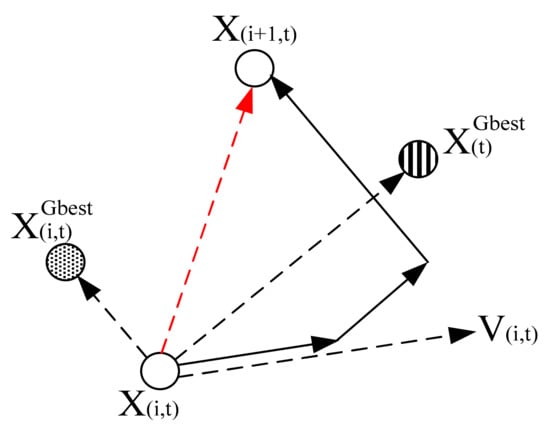
Figure 1.
Searching orientation of the ith particle in PSO.
Despite the simple concept and easy implementation of the proposed method, its superiority over other methods is proven in many applications. In the following, considering the impact of velocity and movement equations on the performance of the PSO, each one is described in detail. For the PSO, the most important section to improve the efficiency is to find algorithm coefficients exactly to increase the local and global optimal search. For the proposed PSO algorithm, w, c1 and c2 are the spring constants of the hook or the acceleration constant, which are obtained using the following equations:
where k is the current iteration, is the total number of iterations, c is the tightness coefficient, c1f and c1i are the initial and final values of c1, and c2f and c2i are the initial and final values of c2. Table 1 represents the values selected for these coefficients in the proposed algorithm.

Table 1.
Values selected for the proposed algorithm.
The coefficients given in Table 1 were determined by a trial-and-error method. Figure 2 shows the flowchart of the proposed algorithm.
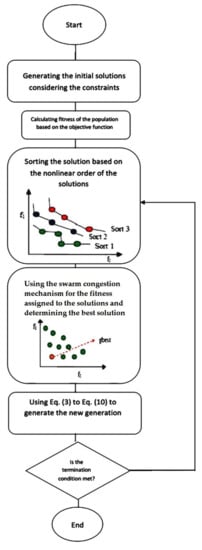
Figure 2.
Flowchart of the proposed algorithm.
3. Power System Stabilizer
The main operation of a PSS is to generate a proper torque on the machine rotor, such that the phase lag between the excitation input and the electric torque is compensated. The output signal of the PSS is proportional to the rotor speed. In Figure 3, a lead-lag PSS is shown.

Figure 3.
Lead-lag PSS.
The transfer function of the PSS of the ith machine is as follows [23]:
In this structure, a high-pass filter is used so that its time constant is adjusted in the range of 0.5 to 20 s and TW is 10 s [23]. The adjustable parameters of PSS are Ki, and time constant T1i–T4i. The lead-lag block in the above structure provides a sufficient phase to compensate for the phase difference between the excitation input and the electric torque. The PSS should be adjusted online to operate under all operating conditions, and sufficient damping is achieved for critical modes. In this paper, the proposed PSO (IPSO) is used to find the optimal design.
4. Proposed Objective Function and Constraints
In this study, an innovative objective function based on the time-domain and various operating conditions of the system is used to adjust the parameters of the PSS. A performance index is defined based on the system dynamics after creating a periodic disturbance in the system, and it is organized for a wide range of operating conditions and to form the measure function of the problem. Since the operating condition of the power system is changing, the proposed objective function for a wide range of operating conditions is defined as follows:
where and are weighting coefficients and J1 and J2 are the two mail parts of objective functions which are calculated by Equations (9) and (10).
The J1 is based on local and inter-area frequency difference and J2 is based on overshoot, undershoot, and settling time of the oscillations. In Equation (9), tsim is the simulation time, NP is the number of operating conditions for the optimization process, t is time operator and to are generators of angular velocity. Moreover, in Equation (10), OV is overshoot, US is undershoot, and Ti is settling time. The PSS design is formulated as a constrained optimization problem with the following constraints [24]:
5. Simulation and Analysis of the Results
In this section, the proposed algorithm is applied to adjust the PSS parameters of the four-machine power system, and its single-line diagram is shown in Figure 4. This system has two areas that are connected via a weak connection line. There is one local oscillation mode in this system in each area, and there is one inter-area oscillation mode. The stress imposed on this system is evaluated using the real power exchanged between the two areas [25].

Figure 4.
The two-area four-machine power system.
All generators are equipped with PSS and an automatic voltage regulator (AVR). The PSS structure includes one filter and two lead-lag blocks. The output signal of the PSS is proportional to the rotor speed of the generators. In this structure, a high-pass filter is used so that its time constant is adjusted in the range of 0.5 to 20 s. In this design, TW is 10 s. The adjustable parameters of PSS are Ki, and time constant T1i–T4i. Thus, 20 parameters are considered as the controllable parameters. The adjustment range of these parameters is given in Table 2 [26,27,28,29,30,31,32,33,34,35,36,37,38,39,40,41,42,43].

Table 2.
The range determined for PSS parameters of the four-machine power system.
To design a robust PSS, the system’s operating conditions are described based on active power (P), and reactive power (Q) at the terminal of the generators, and the load points of C1, C2, L1, and L2. To this end, the operating conditions are considered as follows:
- The system with rated loading;
- The system under heavy loading (20% increase in the rated value);
- The system under low loading (20% decrease in the rated value).
The proposed algorithm solves the constrained nonlinear optimization problem to calculate the optimal set of PSS parameters. In the following, the proposed PSS is applied to the sample four-machine power system to represent its robust performance, and its results are compared with the classical adjusted PSS in two scenarios.
- Scenario 1
In this scenario, as mentioned, PSS is installed on all four machines. The results obtained from this algorithm are compared with those of the methods given in Table 3. Figure 5 shows convergence variations of the system of study. Figure 6, Figure 7, Figure 8 and Figure 9 shows the changes in the generator speeds. The genetic algorithm (GA) and the bacteria foraging algorithm (BFA) were also used to design the PSSs. The optimal parameters obtained for the PSS are given in Table 3.

Table 3.
The results obtained for the four-machine PSS.
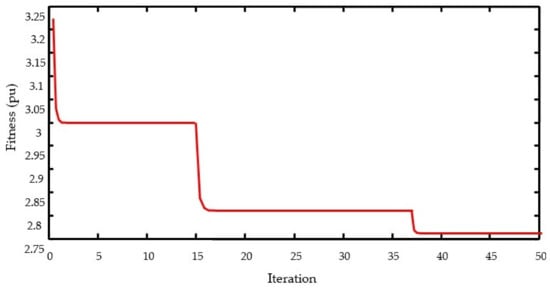
Figure 5.
Convergence changes of the four-machine system in the first scenario.
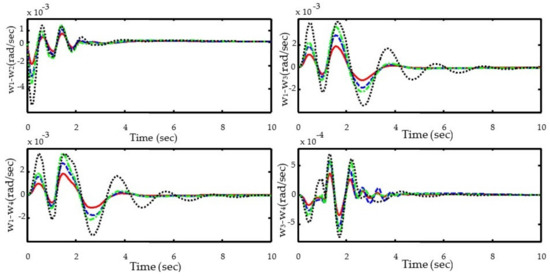
Figure 6.
Angular velocity deviation for the first scenario for the rated load. Proposed (red line), BFA (blue dashed line), GA (green dash–dotted line), classic (black dots).
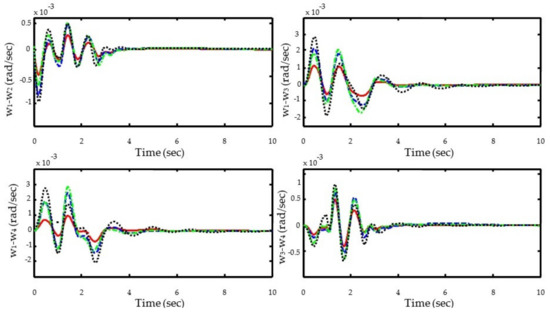
Figure 7.
Angular velocity deviation for the first scenario for heavy load; proposed (red line), BFA (blue dashed line), GA (green dash–dotted line), classic (black dots).
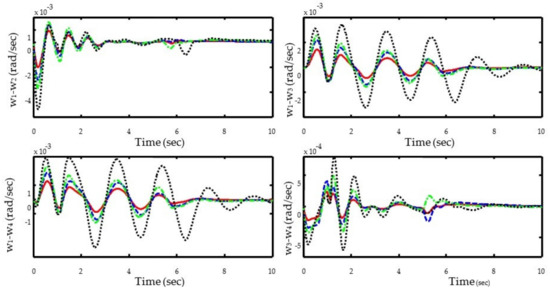
Figure 8.
Angular velocity deviation for the first scenario for low load; proposed (red line), BFA (blue dashed line), GA (green dash–dotted line), classic (black dots).
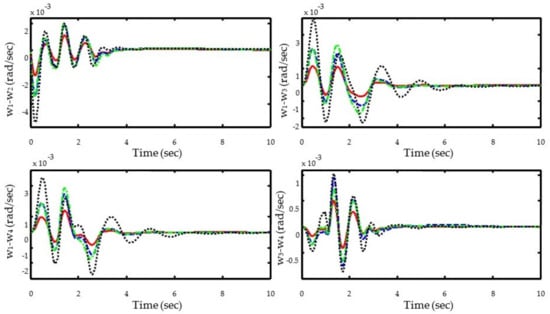
Figure 9.
Angular velocity deviation for the first scenario for rated load and line disconnection; proposed (red line), BFA (blue dashed line), GA (green dash–dotted line), classic (black dots).
Considering the simulation results, it is seen that all four PSSs can damp the oscillations or stabilize the system at all operating points. As can be seen, although the genetic and classic PSSs reduce the oscillation amplitude, the PSO-based PSS converges faster and achieves the solution faster. In this method, the system performance under various uncertainties is desired with proper efficiency. Countering the changes of the system, this PSS reduces the oscillation amplitudes compared to genetic and classic methods. Moreover, it reduces the overshoot of the system with a proper settling time. Table 4 compares these methods numerically. Table 5 represents the operating conditions of interest.

Table 4.
The numerical comparison between the proposed methods.

Table 5.
The numerical comparison between the proposed methods.
- Scenario 2
In this scenario, the optimal location of the PSS is studied. The results are shown in the following figures. Table 6 shows the optimal values obtained for the PSS parameters of the studied system. Figure 10 shows the convergence variations of the studied system for locating the PSS using the proposed algorithm. Figure 11 and Figure 12 show the speed variations of the generators.

Table 6.
The optimal parameters obtained for locating the PSS of the four-machine power system.
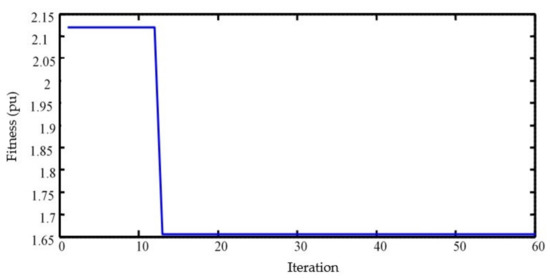
Figure 10.
Convergence changes of the PSO in locating the PSS of the four-machine power system in the second scenario.

Figure 11.
Angular velocity deviation for the second scenario for the rated load; proposed (red line), BFA (blue dashed line), GA (green dash–dotted line).
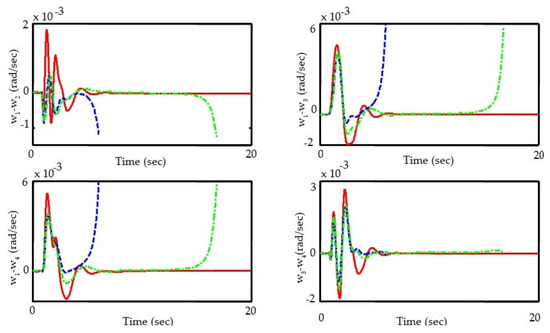
Figure 12.
Angular velocity deviation the second scenario for the heavy load; proposed (red line), BFA (blue dashed line), GA (green dash–dotted line).
As the results show, the proposed algorithm found the optimal location of PSS in generators 2 and 4, while the other algorithms located the PSSs in generators 1 and 4. The results demonstrate stability improvement of the multi-machine system by locating the PSSs in the locations of interest. The results for rated and heavy loads are represented. As can be seen, the PSS based on the proposed algorithm performs favorably and decreases the oscillation amplitude compared to the BFA-based PSS with excellent settling time.
In order to more accurately evaluate the performance of the proposed algorithm, the results obtained from the optimization by this algorithm are compared with the results of the whale optimization algorithm (WOA) [44]. The performance of the designed PSSs has been evaluated by applying a symmetrical fault. The simulation results are accumulated in Table 7.

Table 7.
Time domain response results.
The simulation results indicate the better performance of the proposed method than other algorithms. The percent of maximum overshoot and settling time for all the generators’ speed deviation for the power system with the proposed PSSs are less than others.
6. Conclusions
In this paper, a modified version of particle swarm optimization and innovative objective function was proposed for the optimal coordination of power system stabilizers. The proposed objective function was a weighted function of two separated functions, one based on the difference in angular velocity of the generators and the other based on the maximum overshoot, undershoot, and settling time of the oscillations. The performance of the designed PSSs was tested on the standard four-machine power system and its results were compared with the results of BFA and GA algorithms. The simulation results indicated that the proposed algorithm converged faster and achieved the desired response faster. In this method, the system performance in the presence of various uncertainties was satisfactory with proper efficiency. This PSS reduced the amplitude of the oscillations compared to GA and classic methods, and reduced the overshoot of the system response with an excellent settling time. In scenario 2, the optimal location of the PSS was studied. Considering the simulation results of the algorithm, the proposed algorithm located the PSS in generators 2 and 4, while in other methods, the PSS was located in generators 1 and 4. The results showed that by locating the PSS in the determined generators, the stability of the multi-machine system improved. The results of rated and heavy load scenarios were evaluated, indicating the desired performance of the proposed algorithm. Moreover, the results showed that the proposed PSS decreased the oscillation amplitude well compared to the GA-based PSS with an excellent settling time. For future research, it is suggested that the PSS design be performed in conditions of uncertainty in power systems. PSS designed online can be a good tool to improve the stability of a power system in conditions of uncertainty.
Author Contributions
Conceptualization, S.L., S.I., M.A.K., H.S., I.C. and K.E.; methodology, M.A.K., H.S., I.C. and K.E.; software, M.A.K., H.S., I.C. and K.E.; validation, S.L., S.I., M.A.K., H.S., I.C. and K.E.; formal analysis, M.A.K., H.S., I.C. and K.E.; investigation, S.L., S.I., M.A.K., H.S., I.C. and K.E.; resources, S.L., S.I., M.A.K. and H.S.; data curation, S.L., S.I., M.A.K., H.S., I.C. and K.E.; writing—original draft preparation, M.A.K. and H.S.; writing—review and editing, M.A.K. and H.S.; visualization, S.L., S.I., M.A.K., H.S., I.C. and K.E.; supervision, M.A.K. and H.S.; project administration, M.A.K. and H.S.; funding acquisition, M.A.K., H.S., I.C. and K.E. All authors have read and agreed to the published version of the manuscript.
Funding
This research received no external funding.
Conflicts of Interest
The authors declare no conflict of interest.
References
- Shokouhandeh, H.; Jazaeri, M. An enhanced and auto-tuned power system stabilizer based on optimized interval type-2 fuzzy PID scheme. Int. Trans. Electr. Energy Syst. 2017, 28, e2469. [Google Scholar] [CrossRef]
- Sreedivya, K.M.; Jeyanthy, P.A.; Devaraj, D. improved design of interval type-2 fuzzy based wide area power system stabilizer for inter-area oscillation damping. Microprocess. Microsyst. 2021, 83, 103957. [Google Scholar] [CrossRef]
- Nakhi, P.R.; Kamarposhti, M.A. Multi objective design of type II fuzzy based power system stabilizer for power system with wind farm turbine considering uncertainty. Int. Trans. Electr. Energy Syst. 2019, 30, 12285. [Google Scholar] [CrossRef]
- Shokouhandeh, H.; Jazaeri, M. Robust design of fuzzy-based power system stabiliser considering uncertainties of loading conditions and transmission line parameters. IET Gener. Transm. Distrib. 2019, 13, 4287–4300. [Google Scholar] [CrossRef]
- Devarapalli, R.; Bhattacharyya, B. Optimal controller parameter tuning of PSS using sine-cosine algorithm. In Metaheuristic and Evolutionary Computation: Algorithms and Applications; Springer: Singapore, 2021; pp. 337–360. [Google Scholar]
- Razmjooy, N.; Razmjooy, S.; Vahedi, Z.; Estrela, V.V.; de Oliveira, G.G. A new design for robust control of power system stabilizer based on Moth search algorithm. In Metaheuristics and Optimization in Computer and Electrical Engineering; Springer: Cham, Switzerland, 2021; pp. 187–202. [Google Scholar]
- Butti, D.; Mangipudi, S.K.; Rayapudi, S.R. An improved whale optimization algorithm for the design of multi-machine power system stabilizer. Int. Trans. Electr. Energy Syst. 2020, 30, 12314. [Google Scholar] [CrossRef]
- Butti, D.; Mangipudi, S.K.; Rayapudi, S. Model order reduction based power system stabilizer design using improved whale optimization algorithm. IETE J. Res. 2021, 1–20. [Google Scholar] [CrossRef]
- Izci, D. A novel improved atom search optimization algorithm for designing power system stabilizer. Evol. Intell. 2021, 314, 1–15. [Google Scholar] [CrossRef]
- Hauser, D.; Taranto, G.N. Analysis of Interarea Modes of the Brazilian Power System Using the Dominant Pole Spectrum Eigensolver Algorithm. J. Control. Autom. Electr. Syst. 2022, 31, 1–8. [Google Scholar] [CrossRef]
- Eslami, M.; Neshat, M.; Khalid, S.A. A Novel Hybrid Sine Cosine Algorithm and Pattern Search for Optimal Coordination of Power System Damping Controllers. Sustainability 2022, 14, 541. [Google Scholar] [CrossRef]
- Alshammari, F.A.; Guesmi, T.; Alzamil, A.A.; Alshammari, B.M.; Alshammari, A.S. Local Search-based Non-dominated Sorting Genetic Algorithm for Optimal Design of Multimachine Power System Stabilizers. Eng. Technol. Appl. Sci. Res. 2021, 11, 7283–7289. [Google Scholar] [CrossRef]
- Sabo, A.; Wahab, N.I.A.; Othman, M.L.; Jaffar, M.Z.A.M.; Beiranvand, H. Optimal design of power system stabilizer for multimachine power system using farmland fertility algorithm. Int. Trans. Electr. Energy Syst. 2020, 30, 12657. [Google Scholar] [CrossRef]
- Naghshbandy, A.H.; Faraji, A. Coordinated design of PSS and unified power flow controller using the combination of CWT and Prony methods with the help of BFA II multi-objective optimisation algorithm. IET Gener. Transm. Distrib. 2019, 13, 4900–4909. [Google Scholar] [CrossRef]
- Devarapalli, R.; Bhattacharyya, B.; Sinha, N.K.; Dey, B. Amended GWO approach based multi-machine power system stability enhancement. ISA Trans. 2021, 109, 152–174. [Google Scholar] [CrossRef] [PubMed]
- Chaib, L.; Choucha, A.; Arif, S.; Zaini, H.G.; El-Fergany, A.; Ghoneim, S.S.M. Robust Design of Power System Stabilizers Using Improved Harris Hawk Optimizer for Interconnected Power System. Sustainability 2021, 13, 11776. [Google Scholar] [CrossRef]
- De Marco, F.; Rullo, P. Damped Nyquist Plot for the Phase and Gain Optimization of Power System Stabilizers. Electr. Power Syst. Res. 2021, 205, 107708. [Google Scholar] [CrossRef]
- Rashwan, A.F.; Ahmed, M.; Mossa, M.R.; Baha-El-Din, A.M.; Alkhalaf, S.; Senjyu, T.; Hemeida, A.M. Explicit adaptive power system stabilizer design based an on-line identifier for single-machine infinite bus. Ain Shams Eng. J. 2021, 13, 101544. [Google Scholar] [CrossRef]
- Yang, S.; Xiong, L.; Huang, S.; He, Y.; Li, P.; He, D.; Wang, J. Optimal node selection of damping controller for power systems with high wind power penetration. Int. J. Electr. Power Energy Syst. 2021, 136, 107716. [Google Scholar] [CrossRef]
- Mujeer, S.A.; Jayaraman, R.; Krishna, P.S.; Kollati, S.; Nayak, M.R. FOPID and state space analysis based PSS for damping of oscillation in multi machine system. Mater. Today Proc. 2021. [Google Scholar] [CrossRef]
- Rodrigues, F.; Molina, Y.; Silva, C.; Ñaupari, Z. Simultaneous tuning of the AVR and PSS parameters using particle swarm optimization with oscillating exponential decay. Int. J. Electr. Power Energy Syst. 2021, 133, 107215. [Google Scholar] [CrossRef]
- Xu, L.; Cao, M.; Song, B. A new approach to smooth path planning of mobile robot based on quartic Bezier transition curve and improved PSO algorithm. Neurocomputing 2021, 473, 98–106. [Google Scholar] [CrossRef]
- Devarapalli, R.; Sinha, N.K.; Márquez, F.P.G. A Review on the Computational Methods of Power System Stabilizer for Damping Power Network Oscillations. Arch. Comput. Methods Eng. 2022, 144, 1–27. [Google Scholar] [CrossRef]
- Alotaibi, I.M.; Ibrir, S.; Abido, M.A.; Khalid, M. Nonlinear Power System Stabilizer Design for Small Signal Stability Enhancement. Arab. J. Sci. Eng. 2022, 46, 1–13. [Google Scholar] [CrossRef]
- Aribowo, W.; Muslim, S.; Suprianto, B.; Haryudo, S.I. Tunicate Swarm Algorithm-Neural Network for Adaptive Power System Stabilizer Parameter. Sci. Technol. Asia 2021, 26, 50–63. [Google Scholar]
- Su, X.-L.; Yang, Y.-Q.; Bai, W.-R.; Chen, C. Damping analysis of power system stabilizer based on transient equivalent circuit. J. Vib. Test. Syst. Dyn. 2022, 6, 53–61. [Google Scholar] [CrossRef]
- Lv, Z.; Guo, J.; Lv, H. Safety Poka Yoke in Zero-Defect Manufacturing Based on Digital Twins. IEEE Trans. Ind. Inform. 2022. Available online: https://ieeexplore.ieee.org/abstract/document/9669046 (accessed on 4 January 2022). [CrossRef]
- Mi, C.; Chen, J.; Zhang, Z.; Huang, S.; Postolache, O. Visual Sensor Network Task Scheduling Algorithm at Automated Container Terminal. IEEE Sens. J. 2022, 22, 6042–6051. [Google Scholar] [CrossRef]
- Zhang, L.; Gao, T.; Cai, G.; Hai, K.L. Research on electric vehicle charging safety warning model based on back propagation neural network optimized by improved gray wolf algorithm. J. Energy Storage 2022, 49, 104092. [Google Scholar] [CrossRef]
- Fang, Z.; Lu, J.; Liu, F.; Xuan, J.; Zhang, G. Open Set Domain Adaptation: Theoretical Bound and Algorithm. IEEE Trans. Neural Netw. Learn. Syst. 2021, 32, 4309–4322. [Google Scholar] [CrossRef]
- Meng, F.; Cheng, W.; Wang, J. Semi-supervised Software Defect Prediction Model Based on Tri-training. KSII Trans. Internet Inf. Syst. 2021, 15, 4028–4042. [Google Scholar] [CrossRef]
- Liu, S.; Liu, C.; Song, Z.; Dong, Z.; Huang, Y. Candidate Modulation Patterns Solution for Five-Phase PMSM Drive System. IEEE Trans. Transp. Electrif. 2021. Available online: https://ieeexplore.ieee.org/abstract/document/9514518 (accessed on 16 August 2021). [CrossRef]
- Liu, S.; Liu, C.; Huang, Y.; Xiao, Y. Direct Modulation Pattern Control for Dual Three-Phase PMSM Drive System. IEEE Trans. Ind. Electron. 2021, 69, 110–120. [Google Scholar] [CrossRef]
- Sui, T.; Marelli, D.; Sun, X.; Fu, M. Multi-sensor state estimation over lossy channels using coded measurements. Automatica 2020, 111, 108561. [Google Scholar] [CrossRef]
- Zhou, H.; Xu, C.; Lu, C.; Jiang, X.; Zhang, Z.; Wang, J.; Xiao, X.; Xin, M.; Wang, L. Investigation of transient magnetoelectric response of magnetostrictive/piezoelectric composite applicable for lightning current sensing. Sens. Actuators A Phys. 2021, 329, 112789. [Google Scholar] [CrossRef]
- Liu, X.; Zheng, W.; Mou, Y.; Li, Y.; Yin, L. Microscopic 3D reconstruction based on point cloud data generated using defocused images. Meas. Control 2021, 54, 1309–1318. [Google Scholar] [CrossRef]
- Ma, Z.; Zheng, W.; Chen, X.; Yin, L. Joint embedding VQA model based on dynamic word vector. PeerJ Comput. Sci. 2021, 7, e353. [Google Scholar] [CrossRef]
- Wang, Y.; Zou, R.; Liu, F.; Zhang, L.; Liu, Q. A review of wind speed and wind power forecasting with deep neural networks. Appl. Energy 2021, 304, 117766. [Google Scholar] [CrossRef]
- Guo, L.; Ye, C.; Ding, Y.; Wang, P. Allocation of Centrally Switched Fault Current Limiters Enabled by 5G in Transmission System. IEEE Trans. Power Deliv. 2021, 36, 3231–3241. [Google Scholar] [CrossRef]
- Guo, C.; Ye, C.; Ding, Y.; Wang, P. A Multi-State Model for Transmission System Resilience Enhancement Against Short-Circuit Faults Caused by Extreme Weather Events. IEEE Trans. Power Deliv. 2020, 36, 2374–2385. [Google Scholar] [CrossRef]
- Yang, Y.; Peng, J.C.-H.; Ye, C.; Ye, Z.-S.; Ding, Y. A Criterion and Stochastic Unit Commitment towards Frequency Resilience of Power Systems. IEEE Trans. Power Syst. 2021, 37, 640–652. [Google Scholar] [CrossRef]
- Purba, S.R.P.; Amarilies, H.S.; Rachmawati, N.L.; Redi, A.A.N.P. Implementation of Particle Swarm Optimization Algorithm in Cross-Docking Distribution Problem. Acta Inform. Malays. 2021, 5, 16–20. [Google Scholar]
- Wang, G.; Hu, Y. Intelligent Control Algorithm of Impulse Current for Two Stage Wide Input Marine Switching Power Supply. J. Coast. Res. 2020, 103, 956. [Google Scholar] [CrossRef]
- Dasu, B.; Sivakumar, M.; Srinivasarao, R. Interconnected multi-machine power system stabilizer design using whale optimization algorithm. Prot. Control Mod. Power Syst. 2019, 4, 2. [Google Scholar] [CrossRef]
Publisher’s Note: MDPI stays neutral with regard to jurisdictional claims in published maps and institutional affiliations. |
© 2022 by the authors. Licensee MDPI, Basel, Switzerland. This article is an open access article distributed under the terms and conditions of the Creative Commons Attribution (CC BY) license (https://creativecommons.org/licenses/by/4.0/).